|
|
|
Relaxercise:
The Feldenkrais Method Made Easy
by David Zemach-Bersin • Bucks Co., PA
In 1942,
Dr. Moshe Feldenkrais, a brilliant and respected physicist, faced one
of the most critical challenges of his lifetime. Because he had suffered
a series of sports related knee injuries, he was now painfully crippled.
Medical specialists offered him surgery, but had given him a disheartening
prognosis. Feldenkrais chose not to undergo the proposed surgery. Instead,
he began to study neurology, anatomy, biomechanics and human movement
development. He knew that in order to walk again, he would have to find
a way to create new neurological connections between his nervous system
and his muscles. After two years of research and experimentation, he emerged
victorious. He had developed a way to improve his body by activating the
natural power of his brain and nervous system. Inspired by his personal
success, Feldenkrais continued to explore the profound link between the
brain and body, and developed hundreds of unique exercises designed to
access the movement learning centers of the brain.
In order for you to take advantage of your body’s extraordinary ability
to improve itself through sensory motor learning (the way our bodies learn
naturally, through trial and error,) you must give your brain an opportunity
to detect and reduce the unnecessary, counterproductive muscular effort
in your body.
Research in neurophysiology has shown that when we exert a lot of muscular
effort, it is impossible for our brain to make the sensory distinction
needed to improve our neuromuscular organization. This is why conventional
exercise, with its reliance on muscular effort, force and speed, actually
restricts your brain’s ability to work on your body’s behalf.
When we use minimal muscular effort, our brain is free to make important
sensory distinctions.
For example, if you hold a heavy object, you have to exert a considerable
amount of muscular effort. If a fly lands on the heavy object as you’re
holding it, you cannot feel the very slight increase in weight. But if
you hold something that is very light, like a feather, you do not need
to exert a lot of muscular effort. If a fly lands on the feather, you
can easily feel the increase in weight because your brain is free to sense
even the slightest difference or change.
Relaxercise® exercises, which we developed from Feldenkrais’
work, apply the powerful neurological rule that less muscular effort produces
more sensory learning and physical improvement. The following exercise
involves slow, easy movements that activate your brain’s movement
centers and generate a flow of valuable information between your brain
and your muscles. Automatically, as if by magic, tension, strain, fatigue
and discomfort will disappear as your neuromuscular system reprograms
itself for better health.
For this exercise you will need a hard or firmly cushioned chair.
Use these Relaxercise® Keys:
• Go slowly.
• Make each movement small and easy.
• Relax as much as you can.
• Rest briefly after each movement.
Starting position: Sit on the forward part of the chair and rest your
hands on your thighs. Rest your feel flat on the floor, shoulder width
apart, directly below your knees.
Repeat each of the following movements 4 to 8 times.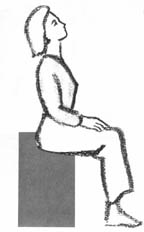
1) Slowly and comfortably raise your head and eyes as if to look
up toward the ceiling. Then return to the starting position (facing forward)
and relax.
• Don’t stretch or strain your neck or back. Your flexibility
will increase automatically.
• As you look up, let your back arch slightly.
• Exhale as you do each movement.
• As you look up, notice exactly how far above your eyes can see
without feeling any strain. Later on, you can measure your
improvement.
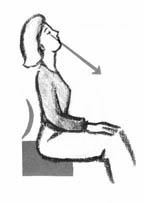
2) Simultaneously, raise your head and arch your back a little,
while looking downward with your eyes.
• Go slowly. This movement will soon be easier and more
comfortable.
• The movement of your head and neck is limited because your head
and eyes are moving in opposite directions.
• Relax your eyes, neck and shoulders.
3) Simultaneously, raise your head and eyes to look up toward the
ceiling while arching your back.
• Is your back arching more easily?
• Can you see a little higher without any strain?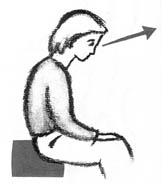
4) Very slowly lower your head as if to look down toward the floor.
Then return to the starting position and relax.
• Make each movement small and easy.
• When you look down, let your back get round.
• Exhale as you do each movement.
• Relax your neck, chest and shoulders.
5) Simultaneously, lower your head and round your back, while raising
your eyes to look upward.
• Notice that the movement of your head and chest is limited because
your head and eyes are moving in opposite directions.
6) Again, raise your head and eyes to look upward, while arching
your back.
• Notice that your eyes can see a little farther upward without strain!
• Feel the middle and upper part of your back beginning to arch a
little more.
7) Let your head hang down, so your chin rests comfortably near
your chest. Then slowly arch your back.
• Relax your neck, stomach and shoulders.
• Notice that your pelvis tilts forward slightly when you arch your
back.
• Exhale while doing each movement.
8) And once more, raise your head and eyes to look upward while
arching your back.
• Feel your spine arching.
• Notice how far upward you can look now, without feeling any strain.
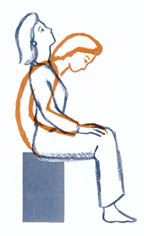
9) Slowly, lift your head and eyes to look upward, while arching your
back. Then slowly lower your head and eyes and round your back.
As you look upward, notice:
• Your shoulder blades move closer together.
• Your stomach relaxes and moves forward.
• Your pelvis tilts forward a little.
• Your chest lifts and moves forward.
• Your body gets a little taller.
As you look downward, notice:
• Your chest flattens.
• Your shoulders and back are rounded.
• Your pelvis tilts backward a little.
• Your body gets a little shorter.
10) Turn your upper body comfortably to the right and stay there.
Then alternately raise your head and eyes to look upward while arching
your back, and then lower your head while rounding your back.
• Remain turned slightly to the right.
• Pause to rest when your head and eyes are lowered.
• To make the movement easier, lift your left hip slightly as you
look up.
• Relax your neck, shoulders and legs as much as possible.
11) Turn your upper body comfortably to the left and stay there.
Then alternately raise your head and eyes to look upward while arching
your back, and then lower your head while rounding your back.
• Remain turned slightly to the left.
• As you look upward, lift your right hip slightly.
• Relax your neck, shoulders and legs as much as you can.
12) Slowly turn to the right, while arching your back and looking
upward. Then, while lowering your head and rounding your back, bring your
body back through the starting position and turn slowly to the left, while
arching your back and looking upward. Lower your head and round your back
as you bring your body through the starting position again and repeat
the movement.
• This movement is smooth and continuous.
• Notice that when you turn to the right and look upward, your left
hip rises a little. And when you turn to the left and look upward, your
right hip rises a little.
• Notice that when you look upward, your shoulder blades move closer
together. And when you look downward, your shoulder blades move farther
apart.
• Arch your back as much as you can without feeling any strain.
• Round your back as much as you can without feeling any strain.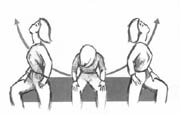
13) Measure your improvement. Lift your head and eyes to look upward
while arching your back.
• When you look up, notice how much farther you can see without any
strain!
• Feel your entire spine bending easily!
• Feel the difference!
And now, relax. Feel how your weight is balanced, resting comfortably
on your pelvic sitting bones. Notice that your posture is more upright.
Your sitting posture has improved because the natural arches of your spine
have been enhanced and restored.
You have completed "A Healthy Spine". When you stand up and
walk around, feel the difference in your posture, flexibility and ease
of movement.
Excerpted with permission from Relaxercise: The Easy New Way
to Health & Fitness, Harper San Francisco, 1990. Available
at bookstores or by calling 800-765-1907.
David Zemach-Bersin is one of the world's foremost Feldenkrais®
Practitioners and the director of the upcoming New York City Feldenkrais®
Method Training Program. For more information about the New York City
Feldenkrais® Training Program or to find a local Practitioner, call
800-482-3357.
|

